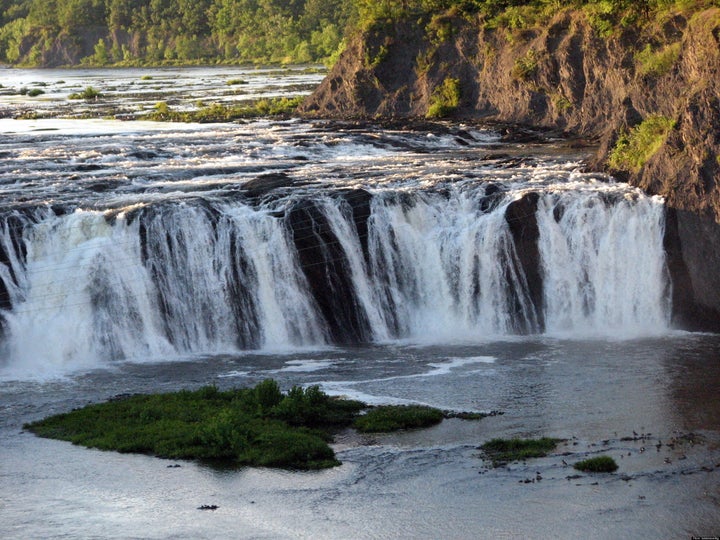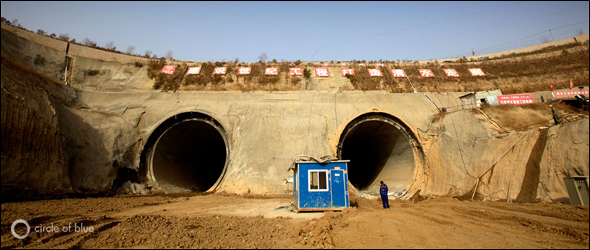
Talk about the mother of all water projects.
My colleagues Aaron Jaffe and Keith Schneider report for Circle of Blue that in 2014 some 9.6 billion cubic meters of water a year (2.5 trillion gallons) will pour through the immense tunnels under construction in Henan Province in northern China, and be sent north to help curb water shortages in more than a dozen cities, including Beijing.
A second line of China's South-North Water Transfer Project should already be operating by then, transporting 14.8 billion cubic meters of water annually from the lower Yangtze River to Tianjin.

Photograph ©2011 Aaron Jaffe/Circle of Blue
The dark openings of two pipelines beneath the Yellow River, like eyes on a flat face of dirt and rock, are unblinking witnesses to the South-North Water Transfer Project.
And this month, in its new 12th Five-Year Plan, the official guide to national development, China is expected to approve construction planning for a third "western" line, according to interviews Circle of Blue conducted with several authorities close to the project. The western line will transport 8 billion more cubic meters of water annually from the Himalayan region in the west to supply the upper and middle reaches of the Yellow River in the north.
Taken together, reports Circle of Blue in the latest chapter of its Choke Point: China series, the three lines of the South-North Water Project are an audacious strategy to solve a commanding threat to China's modernization: the increasingly dire confrontation between rising energy demand in a nation that is steadily getting drier. China's plan is to eventually remove 36 billion cubic meters of water every year (9.5 trillion gallons) from the Yangtze River Basin, which drains much of the nation's central and western regions, and ship it north. That is tantamount to reversing the flow of the Missouri River, which drains the Great Plains and part of the Northwest in the United States, and sending it back to Montana.
It's no surprise ever since construction began in 2002, the South-North Water Project has generated a strong current of public comment. China's government authorities insist the project, now estimated to cost $US 62 billion, is essential to developing cities and energy-rich provinces of northern and western China, the fastest growing regions in the country, which are running out of water.
"Transferring water from the south to north makes perfect sense," said Wang Hao, director of the Water Resources Department at the state-run China Institute of Water Resources and Hydropower Research in Beijing, and one of China's most influential government water scientists.
Wei Zhimin, a water expert in Hebei Province within a unit of the Ministry of Water Resources, said last year in an interview with Xiaoxiang Evening News that the South-North Project would not solve north China's water crisis, but was nevertheless essential.
"Lifeline is one word to describe it," Wei said. "And by lifeline I mean a lifeline for north China, Beijing, Tianjin and Hebei included."
But the project's critics -- among them academics, economists and environmental leaders -- assert that the magnitude and cost of building and operating the continental water transport system would produce a cascade of unintended consequences that could overwhelm benefits to China.
These consequences include much higher municipal, agricultural and industrial water prices, damage to aquatic environments, more treatment facilities for Yangtze water that is currently too polluted to use and continuing water shortages in northern China, and possibly in southern China, too. Most importantly, reports Circle of Blue, water from the South-North project won't relieve the serious choke point that's developed in the northern coal-rich provinces where China can't tap new reserves because of ongoing water scarcity.
"We should take no pride in doing such a project," said Ma Jun, an author and director of the Institute of Public and Environmental Affairs, a non-governmental organization in Beijing. "This is a moment for us, a sobering moment for us, to reflect upon how we drove ourselves to such a situation."
Read more of the Choke Point: China series at Circle of Blue.
